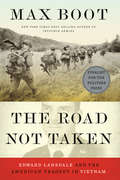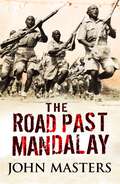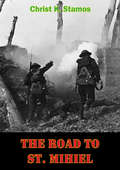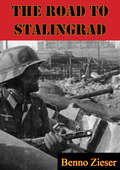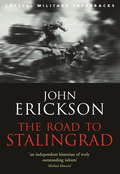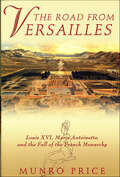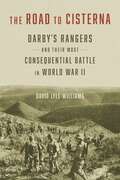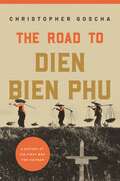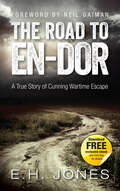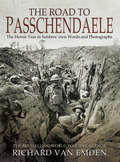- Table View
- List View
The Road Not Taken: Edward Lansdale And The American Tragedy In Vietnam
by Max BootA NEW YORK TIMES BESTSELLER In chronicling the adventurous life of legendary CIA operative Edward Lansdale, The Road Not Taken definitively reframes our understanding of the Vietnam War. In this epic biography of Edward Lansdale (1908– 1987), the man said to be the fictional model for Graham Greene’s The Quiet American, best-selling historian Max Boot demonstrates how Lansdale pioneered a “hearts and mind” diplomacy, first in the Philippines, then in Vietnam. It was a visionary policy that, as Boot reveals, was ultimately crushed by America’s giant military bureaucracy, steered by elitist generals and blueblood diplomats who favored troop build-ups and napalm bombs over winning the trust of the people. Through dozens of interviews and access to neverbefore-seen documents—including long-hidden love letters—Boot recasts this cautionary American story, tracing the bold rise and the crashing fall of the roguish “T. E. Lawrence of Asia” from the battle of Dien Bien Phu to the humiliating American evacuation in 1975. Bringing a tragic complexity to this so-called “ugly American,” this “engrossing biography” (Karl Marlantes) rescues Lansdale from historical ignominy and suggests that Vietnam could have been different had we only listened. With reverberations that continue to play out in Iraq and Afghanistan, The Road Not Taken is a biography of profound historical consequence.
The Road Past Mandalay (W&N Military)
by John MastersThe second part of the bestselling novelist's dramatic autobiography about his time in the Gurkhas during the second world warThis is the second part of John Masters' autobiography: how he fought with his Gurkha regiment during World War II until his promotion to command one of the Chindit columns behind enemy lines in Burma. Written by a bestselling novelist at the height of his powers, it is an exceptionally moving story that culminates in him having to personally shoot a number of wounded British soldiers who cannot be evacuated before their position is overrun by the Japanese. It is an uncomfortable reminder that Churchill's obsession with 'special forces' squandered thousands of Allied lives in operations that owed more to public relations than strategic calculation. This military and moral odyssey is one of the greatest of World War II frontline memoirs.
The Road Past Monchy: Fighting the First World War at Arras, 1914–1918
by Terence LoveridgeTerence Loveridge offers a unique look at the land and air operations around the strategic village of Monchy-le-Preux at the center of the western front during World War I. The story of the Great War is usually one of condemnation or rehabilitation of strategists and consecration of the common soldier, while the story of those who planned, directed, and led operations on the ground has generally been overlooked.Loveridge uses experiences of junior leaders fighting around the key terrain of Monchy-le-Preux to challenge the currently accepted views and reveal that the Great War, despite subsequent impression, was a surprisingly dynamic effort conducted in an arena of constantly evolving practices, techniques, and technology. Less well known than its contemporary campaigns at the Somme, Verdun, or Passchendaele, Monchy also carries less preconceived baggage and thus offers a prime opportunity to reevaluate the accepted wisdom of the events, personalities, and understandings of the Great War.The Road Past Monchy offers readers a unique chance to uncover the "lost" perspective of junior war leaders in a theater of war that saw almost continuous operations from 1914 through to 1918.
The Road Taken
by Michael Buerk'Dawn, and as the sun breaks through the piercing chill of night on the plain outside Korem it lights up a biblical famine, now, in the Twentieth Century.'Those words opened Michael Buerk's first report on the Ethiopian famine for the 6 o'clock news on October 24th 1984. His reports sent shock waves round the world. The Live Aid concert, a direct consequence of Bob Geldof watching that broadcast, was watched by half the planet.Michael Buerk has reported on some of the biggest stories in our lifetime: the Flixborough chemical plant fire, the Birmingham pub bombing, Lockerbie. He was in Buenos Aires at the start of the Falklands War; he reported the death throes of apartheid in South Africa. He was the face of the BBC flagship evening news for many years and has fronted everything from the popular BBC1 series 999 to the erudite Radio 4 programme The Moral Maze. He has won every major award and is universally admired and respected for his intelligent and honest journalism.Here, he also reveals the private Michael Buerk, his bigamist father, his long and happy marriage to Christine and his delight at fatherhood.
The Road To Berlin: Continuing The History Of Stalin's War With Germany
by John EricksonBeginning with the destruction of the German Sixth Army at Stalingrad, The Road to Berlin is the story of how the Red Army drove the Germans from its territory, and finally invaded the Reich. Using an enormous range of primary sources - Soviet, German and Eastern European - John Erickson describes fighting and hardship on a scale almost unimaginable in the West. He provides a detailed narrative of all the battles on all the fronts, and also of the Soviet system of war which achieved, under maximum stress, near-impossible feats in the field and in the factories. The book also tells of the diplomatic moves and counter-moves, including the all-important conferences at Tehran and Yalta. Comprehensive, compelling and immensely readable, it is an indispensable book for any student of the Second World War.
The Road To Berlin: Continuing The History Of Stalin's War With Germany
by Prof John EricksonBeginning with the destruction of the German Sixth Army at Stalingrad, The Road to Berlin is the story of how the Red Army drove the Germans from its territory, and finally invaded the Reich. Using an enormous range of primary sources - Soviet, German and Eastern European - John Erickson describes fighting and hardship on a scale almost unimaginable in the West. He provides a detailed narrative of all the battles on all the fronts, and also of the Soviet system of war which achieved, under maximum stress, near-impossible feats in the field and in the factories. The book also tells of the diplomatic moves and counter-moves, including the all-important conferences at Tehran and Yalta. Comprehensive, compelling and immensely readable, it is an indispensable book for any student of the Second World War.
The Road To St. Mihiel [Illustrated Edition]
by Christ K. StamasIncludes The Americans in the First World War Illustration Pack – 57 photos/illustrations and 10 mapsIN THE ROAD TO ST. MIHIEL, Christ Stamas takes “the road back” and with a retrospective eye views his personal experiences in “No Man’s land” during the cataclysmic years of World War I.
The Road To Stalingrad
by Alec Brown Benno ZieserSTALINGRAD...an eyewitness report of World War II’s most decisive battle.Drafted into the German infantry when he was scarcely out of school, Benno Zieser fought his way deep into Soviet Russia—advancing, retreating, digging in, destroying tanks with hand grenades, battling snipers, killing the enemy in hand-to-hand combat.Outnumbered and outmaneuvered, he and his platoon struggled on, till their bravery was no longer an act of patriotism but a desperate effort to survive. Few of them did. At Stalingrad, the Wehrmacht soldiers reached the end of the line: nothing could spring the giant trap set by Russian crack troops closing in on them.Zieser’s account of the war’s most brutal battle is intensely moving and honest—a personal ordeal with a universal meaning.On the last day of January, 1943, the German Sixth Army surrendered to the Russians at Stalingrad. After a winter campaign of unparalleled horror and hardship, the Wehrmacht was beaten.THE ROAD TO STALINGRAD is a shattering eyewitness account of that lost battle—written by a survivor. Benno Zieser was drafted at the age of nineteen and fought in the infantry at Stalingrad. In this book he tells of his first naive enthusiasm—then the shocking realities:The frozen wastes of an unconquerable continent...gutted roads strewn with abandoned equipment...the anonymous graves by the wayside...the colossal fraud behind Hitler’s promise of victory.Not since All QUIET ON THE WESTERN FRONT has a German author written such a powerful indictment of war—but Benno Zieser’s book is fact, not fiction.
The Road To Stalingrad: Stalin's War With Germany (W&N Military)
by Prof John EricksonIn The Road to Stalingrad, Professor Erickson takes us in detail from the inept command structures and strategic delusions of the pre-invasion Soviet Union, through the humiliations as her armies fell back on all fronts before the Barbarossa onslaught, until the tide turned at last at Stalingrad. Unsparingly, he assesses the generals and political leaders and analyses the confusions and wranglings within both Allied and Axis commands. The climax, the grinding battle for Stalingrad, leaves the Red Army poised for its majestic counter-offensive, Operation 'Uranus', discovering it had 'caught a tiger by the tail'.
The Road from Versailles: Louis XVI, Marie Antoinette, and the Fall of the French Monarchy
by Munro Price“Through brilliant detective work, Price has uncovered documents that shed a definitive light on the French Crown's policy toward the revolution.” —Library JournalIn acclaimed historian Munro Price's powerful new book, he confronts one of the enduring mysteries of the French Revolution—what were the true actions and feelings of Louis XVI and Marie Antoinette as they watched their sovereignty collapse?Dragged back from Versailles to Paris by the crowd in October 1789, the king and queen became prisoners in the capital. They were compelled for their own safety to approve the Revolution and its agenda. Yet, in deep secrecy, they soon began to develop a very different, and dangerous, strategy. The precautions they took against discovery, and the bloody overthrow of the monarchy three years later, dispersed or obliterated most of the clues to their real policy. Much of this evidence has until now remained unknown.The Road from Versailles reconstructs in detail, for the first time, the king and queen's clandestine diplomacy from 1789 until their executions. To do so, it focuses on a vital but previously ignored figure, the royal couple's confidant, the baron de Breteuil. Exiled from France by the Revolution, Breteuil became their secret prime minister, and confidential emissary to the courts of Europe.Along with the queen's probable lover, the comte de Fersen, it was Breteuil who organized the royal family's dramatic dash for freedom, the flight to Varennes. Breteuil's role is crucial to an understanding of what Louis and Marie Antoinette secretly felt and thought during the Revolution. To unlock these secrets, The Road from Versailles draws on highly important unpublished and previously unknown material.
The Road to Cisterna: Darby’s Rangers and Their Most Consequential Battle in World War II
by David Lyle WilliamsThe Road to Cisterna is the story of Darby’s Rangers, an elite American army unit in World War II, selected for toughness and specially trained in beach landings and lightning raids deep behind enemy lines. Commanded by Colonel William Orlando Darby, the 1st Ranger Battalion spearheaded landings in North Africa and helped defeat German general Erwin Rommel—the Desert Fox—in Tunisia. Its success inspired the creation of two more battalions led by Darby in the invasions of Sicily and the Italian mainland. The Rangers’ record of victories ended in central Italy at the Battle of Cisterna, where a force of almost sixty thousand Germans wiped them out. The German forces captured all but a few of the survivors, but many Rangers made daring escapes from prisoner-of-war camps. Of the Rangers who fought that battle, forty-six tell their stories in this book.David Lyle Williams spent over two decades collecting the memories of Darby Rangers, enabling him to compile an unprecedentedly thorough history of the unit. Unlike previous accounts, more than 160 Rangers speak here in their own words and voices, giving an intimate picture of their combat experiences, enabling the reader to know them as individuals.
The Road to Damascus
by Linda Evans John RingoWhen a ruthless political regime seizes power on a world struggling to recover from alien invasion, a former war hero finds herself leading a desperate band of freedom fighters.
The Road to Delhi
by M. SivaramAlthough the peaceful struggles of Mahatma Gandhi are well known in the West, the armed resistance of many Indians during World War II is far less understood; this epic drama ads an important layer to the history of India and the British Empire. The east Asian battlefronts serve as the backgrounds for this story of the attempt by patriotic Indians to drive the British out of their Motherland and gain independence; of the fanatic ambition to attain this goal by the man who chose to be called "Nataji" (the leader), Subhas Chandra Bose; and of the Indian Independence League, ingratiating themselves to the Japanese to further their end while the Japanese happily appeared to reciprocate to gain the Indians' support against the British.The action and drama that filled this battle within the larger scale war is vividly told in this first person narrative by one who remembers what it feels like to have closely escaped death and is grateful to be alive to tell about it. Author Sivaram, who enjoyed the confidence of Netaji Bose and was appointed by him to several positions of responsibility during the Free India campaign, is uniquely qualified to tell this stirring tale.
The Road to Delhi
by M. SivaramAlthough the peaceful struggles of Mahatma Gandhi are well known in the West, the armed resistance of many Indians during World War II is far less understood; this epic drama ads an important layer to the history of India and the British Empire. The east Asian battlefronts serve as the backgrounds for this story of the attempt by patriotic Indians to drive the British out of their Motherland and gain independence; of the fanatic ambition to attain this goal by the man who chose to be called "Nataji" (the leader), Subhas Chandra Bose; and of the Indian Independence League, ingratiating themselves to the Japanese to further their end while the Japanese happily appeared to reciprocate to gain the Indians' support against the British.The action and drama that filled this battle within the larger scale war is vividly told in this first person narrative by one who remembers what it feels like to have closely escaped death and is grateful to be alive to tell about it. Author Sivaram, who enjoyed the confidence of Netaji Bose and was appointed by him to several positions of responsibility during the Free India campaign, is uniquely qualified to tell this stirring tale.
The Road to Delhi
by M. SivaramAlthough the peaceful struggles of Mahatma Gandhi are well known in the West, the armed resistance of many Indians during World War II is far less understood; this epic drama ads an important layer to the history of India and the British Empire. The east Asian battlefronts serve as the backgrounds for this story of the attempt by patriotic Indians to drive the British out of their Motherland and gain independence; of the fanatic ambition to attain this goal by the man who chose to be called "Nataji" (the leader), Subhas Chandra Bose; and of the Indian Independence League, ingratiating themselves to the Japanese to further their end while the Japanese happily appeared to reciprocate to gain the Indians' support against the British.The action and drama that filled this battle within the larger scale war is vividly told in this first person narrative by one who remembers what it feels like to have closely escaped death and is grateful to be alive to tell about it. Author Sivaram, who enjoyed the confidence of Netaji Bose and was appointed by him to several positions of responsibility during the Free India campaign, is uniquely qualified to tell this stirring tale.
The Road to Dien Bien Phu: A History of the First War for Vietnam
by Christopher GoschaA multifaceted history of Ho Chi Minh’s climactic victory over French colonial might that foreshadowed America’s experience in VietnamOn May 7, 1954, when the bullets stopped and the air stilled in Dien Bien Phu, there was no doubt that Vietnam could fight a mighty colonial power and win. After nearly a decade of struggle, a nation forged in the crucible of war had achieved a victory undreamed of by any other national liberation movement. The Road to Dien Bien Phu tells the story of how Ho Chi Minh turned a ragtag guerrilla army into a modern fighting force capable of bringing down the formidable French army.Taking readers from the outbreak of fighting in 1945 to the epic battle at Dien Bien Phu, Christopher Goscha shows how Ho transformed Vietnam from a decentralized guerrilla state based in the countryside to a single-party communist state shaped by a specific form of “War Communism.” Goscha discusses how the Vietnamese operated both states through economics, trade, policing, information gathering, and communications technology. He challenges the wisdom of counterinsurgency methods developed by the French and still used by the Americans today, and explains why the First Indochina War was arguably the most brutal war of decolonization in the twentieth century, killing a million Vietnamese, most of them civilians.Panoramic in scope, The Road to Dien Bien Phu transforms our understanding of this conflict and the one the United States would later enter, and sheds new light on communist warfare and statecraft in East Asia today.
The Road to Dunkirk: The British Expeditionary Force and the Battle of the Ypres-Comines Canal, 1940
by Charles More&“A detailed and fascinating account&” of a little known WWII showdown in Belgium between the British Expeditionary Force and the German army (Barnsley Chronicle). This is an important reassessment of a critical period in the British Expeditionary Force&’s fight against the German armies invading France in 1940. On May 25, Lord Gort, the British commander, took the decision to move 5th Division north in order to plug a growing gap in his army&’s eastern defenses. Over the next three days the division fought a little-known engagement, the Battle of the Ypres-Comines Canal, to hold the Germans at bay while the rest of the BEF retreated toward Dunkirk. The book describes the British Army of 1940 and outlines the early stages of the campaign before explaining the context of Gort&’s decision and why it was made. Then, using British and German sources, it shows how the British doggedly defended their line against heavy German attacks, and demonstrates that the Expeditionary Force was far more than the badly equipped and undertrained army many historians have represented it as. This fresh look at the campaign also casts new light on other aspects such as the impact of the Luftwaffe and the Dunkirk evacuation itself. &“This book is important for all those interested in the fighting which proceeded the general retreat to and evacuation from Dunkirk. The author has trawled numerous archival sources, which are well cited in this elegantly produced book.&” —Journal of the Society for Army Historical Research
The Road to En-dor: A True Story Of Cunning Wartime Escape
by Neil Gaiman E. H. JonesThe incredible true story of two WWI POWs who used amateur magic to convince their captors that they were in touch with the spirit worldCaptured during World War I, Lieutenant E. H. Jones, a Welsh officer in the Indian Army, and Lieutenant C. W. Hill, an Australian serving in the R.A.F., were prisoners of war at the Yozgad prison camp in Turkey. Duty-bound as officers to attempt to escape, Jones sensed that what had previously been the harmless fun of fooling around with a homemade Ouija board could be turned into something much more productive. Playing on the credulous nature of their captors, Hill and Jones weaved an incredibly elaborate plot, hatched to plan their escape. Acting as mediums for the Ouija board, they attempted to convince their captors that they were gradually descending into insanity—which, had it been true, would have seen them repatriated. A true story of bravery, dedication, and extreme hardship, this book is a fascinating insight account of a daring escapade. As well as containing astonishing original materials including photographs, letters, and postcards, the book contains a preface by the author's grandson, as well as a foreword by Neil Gaiman who is linked to a film which is currently in pre-production. A free companion ebook is available to download from the Hesperus website (www.hesperuspress.com/the-road-to-en-dor) which includes back stories on the characters, maps, letters,and coded messages; and an exclusive short story written by Jones.
The Road to Jerusalem: Book One Of The Crusades Trilogy (Crusades Trilogy #1)
by Jan GuillouFate sets a young Swedish noble on a course for war in the Holy Land in this international bestselling epic trilogy opener.Born in 1150 to a noble Swedish family and coming of age at a monastery under the tutelage of a Cistercian monk and a former Knight Templar, young Arn Magnusson is sent to fulfill his destiny beyond the cloister walls. But the world awaiting him is a place at odds with his monastic ways. And when the murder of a king engulfs Western Götaland into a whirlwind of intrigue and ruthless power plays, headstrong and naïve Arn is forced to leave behind the woman he loves and take up arms to battle infidels in the Holy Land.The first book in the international bestselling Crusades Trilogy, this thrilling epic of betrayal, faith, blood, and love sets “a Shakespearian quest for power” (Corriere della Sera, Italy) against the backdrop of the Holy Wars, witnessed through a vibrant, unorthodox lens.Praise for The Road to Jerusalem“The first volume of Jan Guillou’s new trilogy . . . involves Swedish politics, familial drama, social oppression, ice fishing, wolf-hunting, political assassination, young sex and the Knights Templar. It’s a great book.” —The Washington Post“Already a best-seller in Europe, this volume will appeal to fans of faithful medieval military fiction.” —Booklist
The Road to Kalamata: A Congo Mercenary's Personal Memoir
by Mike HoareThe Road to Kalamata is the real-life adventure story of the 4 Commando team of mercenary soldiers, as told by their leader, Col. Mike Hoare. At the close of 1960, the newly formed independent state of Katanga in central Africa recruited Hoare and his team to suppress a rebellion by the Baluba, a fierce tribe of warriors rumored to be cannibals and known to torture and dismember any enemy soldiers unlucky enough to be captured. The events recounted in this book occurred in the Congo during the Katanga campaign of 1961. With insight that only an officer with extensive battlefield experience can bring to this subject, Colonel Hoare chronicles the metamorphosis of 4 Commando from a loose assembly of individuals into a highly organized fighting unit, while also taking the reader inside the minds and hearts of men who sell their military skills for money. What emerges is a compelling and complex portrait of genuine adventurers, "a breed of men which," writes Hoare, "has almost vanished from the face of the earth." Paladin Press is pleased to make available once again this engaging, colorful and thoughtful account, originally published in 1989, complete with a new foreword by the 20th century's most famous mercenary and one of its most eloquent storytellers.
The Road to Oran: Anglo-French Naval Relations, September 1939-July 1940 (Cass Series: Naval Policy And History Ser.)
by David BrownOn 3 July 1940, soon after the collapse of the French front and France's request for an armistice, a reluctant Royal Navy commander opened fire on the French Navy squadron at Mers-el-Kebir. Some 1,300 French sailors lost their lives.The late David Brown's detailed account finally conveys an objective understanding of the course of events that led u
The Road to Passchendaele: The Heroic Year in Soldiers' Own Words and Photographs
by Richard van EmdenPasschendaele is the next volume in the highly regarded series of books from the best-selling First World War historian Richard van Emden. Once again, using the winning formula of diaries and memoirs, and above all original photographs taken on illegally held cameras by the soldiers themselves, Richard tells the story of 1917, of life both in and out of the line culminating in perhaps the most dreaded battle of them all, the Battle of Passchendaele. His pervious book, The Somme, has now sold nearly 20,000 copies in hardback and softback, proving that the public appetite is undiminished for new, original stories illustrated with over 150 rarely or never-before-seen battlefield images. The author has an outstanding collection of over 5,000 privately taken and overwhelmingly unpublished photographs, revealing the war as it was seen by the men involved, an existence that was sometimes exhilarating, too often terrifying, and occasionally even fun. Richard van Emden interviewed 270 veterans of the Great War, has written extensively about the soldiers' lives, and has worked on many television documentaries, always concentrating on the human aspects of war, its challenge and its cost to the millions of men involved. This book will be published in June 2017, in time for the 100th anniversary of the epic Battle of Passchendaele which began on 31st July 1917 Richard van Emdens books sold over 650,000 books and have appeared in The Times bestseller chart on a number of occasions. He lives in West London and regularly appears on television, mostly recently as BBC1s historian for the national commemorations of the Somme Battle. He has appeared on over forty television documentaries and has written nineteen books on the First World War.
The Road to Pearl Harbor: The Coming of the War Between the United States and Japan
by Herbert FeisThese works are now made available through an environmentally friendly, print-on-demand basis, using only what is necessary to meet the required demands of an interested public. We invite you to learn of the records of the U.S. Government, heightening the knowledge and debate that can lead from such publications.
The Road to Rome (The Forgotten Legion Chronicles)
by Ben KaneIn 48 B.C., having survived a disastrous campaign in Pythia as part of the Forgotten Legion and spent years fighting their way back to Rome, Romulus and Tarquinius have finally made it as far as Alexandria. On arrival, though, they find themselves in the midst of the Roman Civil War, are press-ganged into Caesar's thinning legions and greatly outnumbered and fighting for their lives against the Egyptian army. Meanwhile in Rome, Romulus' twin sister Fabiola, having caught only a glimpse of her long-missing twin before being forced to flee Egypt for Rome, lives in fear for her life, loved by Brutus, but wooed by Marcus Antonius, his deadly enemy. From the battlefields of Asia Minor and North Africa, to the lawless streets of Rome and the gladiator arena, they all face death and danger daily, until 44 B.C. when their individual roads all lead them to Rome where the future of the republic lies unexpectedly in their hands.
The Road to Russia: Arctic Convoys, 1942–45
by Bernard EdwardsBernard Edwards, the formidable naval historian, has researched the fate of Convoys PQ13 and PQ17 bound from Iceland to Northern Russia as well as the westbound Convoy QP13. Attacked relentlessly by aircraft and U-boats, the former lost a total of thirty ships while QP13 ran into a British minefield off Iceland, losing seven vessels. The Road to Russia is an important addition to the bibliography of this bitterly fought campaign.
